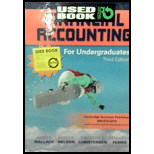
1)
Calculate the company’s return on sales ratio for 2012, 2013, and 2014. Explain the return on sales trend.
1)
Explanation of Solution
Return on sales ratio: The ratio which evaluates the amount of net income earned for every dollar of net sales is referred to as return on sales ratio.
Compute the return on sales ratio for Incorporation G for the year 2012.
Net income = $1,567.3million
Net sales = $16,657.9million
Compute the return on sales ratio for Incorporation G for the year 2013.
Net income = $1,855.2 million
Net sales = $17,774.1 million
Compute the return on sales ratio for Incorporation G for the year 2014.
Net income = $1,824.4 million
Net sales = $17,909.6 million
Trends:
- Profitability of Incorporation G is measured by return on sales ratio.
- The ratio is has increased from 9.4% in 2012 to 10.43% in 2013 and decreased to 10.18% in 2014.
- This shows that the company’s profitability has decreased slightly.
2)
Calculate the company’s
2)
Explanation of Solution
Current ratio: Current ratio is one of the
Compute current asset ratio for Incorporation G for the year 2013.
Current assets = $4,298.9 million
Current liabilities = $5293.9 million
Compute current asset ratio for Incorporation G for the year 2014.
Current assets = $4393.5 million
Current liabilities = $5,423.5 million
Trends:
- Liquidity of Incorporation G is evaluated by current ratio.
- Current ratio shows trend indicates there is no change in current ratio (0.81) in 2013 and in 2014.
- This shows that there is no change in the capacity to pay for short-term liabilities.
3)
Calculate the Company’s debt-to-total-assets ratio for 2013 and 2014. Explain the trend in debt-to-total-assets ratio.
3)
Explanation of Solution
Compute debt-to-total-assets ratio for Incorporation G for the year 2013.
Total assets = $22,658 million
Total liabilities = $14,562 million
Compute debt-to-total-assets ratio for Incorporation G for the year 2014.
Total assets = $23,145 million
Total liabilities = $15,156.2 million
Trends:
- Liquidity of Incorporation G is measured by debt-to-total-assets ratio.
- The ratio shows an increasing trend from 64.26% in 2013 to 65.48% in 2014.
- This shows that the repaying capacity of the corporation has decreased.
4)
Calculate the Company’s
4)
Explanation of Solution
Free cash flow: Free cash flow describes the net cash provided from operating activities after making required adjustments for capital expenditures. In other words, it is the cash flow arrived after making payment for capital expenditures.
| Particulars | 2012 | 2013 | 2014 |
| Free cash flows: | |||
| Cash flow from operating activities | $2,407.2 | $2,926 | $2,541 |
| Less: Cash investment in property, plant and equipment | 675.9 | 613.9 | 663.5 |
| Free cash flow | $1,731.3 | $2,312.1 | $1,877.5 |
Table (1)
Trends:
- The ratio shows a mixed trend from 2012 to 2014.
- Incorporation G had a healthy free cash flow in the years to repay its lenders, pay dividends to stockholders.
Want to see more full solutions like this?
Chapter 4 Solutions
FINANCIAL ACCT.F/UNDERGRADS-W/ACCESS

 AccountingAccountingISBN:9781337272094Author:WARREN, Carl S., Reeve, James M., Duchac, Jonathan E.Publisher:Cengage Learning,
AccountingAccountingISBN:9781337272094Author:WARREN, Carl S., Reeve, James M., Duchac, Jonathan E.Publisher:Cengage Learning, Accounting Information SystemsAccountingISBN:9781337619202Author:Hall, James A.Publisher:Cengage Learning,
Accounting Information SystemsAccountingISBN:9781337619202Author:Hall, James A.Publisher:Cengage Learning, Horngren's Cost Accounting: A Managerial Emphasis...AccountingISBN:9780134475585Author:Srikant M. Datar, Madhav V. RajanPublisher:PEARSON
Horngren's Cost Accounting: A Managerial Emphasis...AccountingISBN:9780134475585Author:Srikant M. Datar, Madhav V. RajanPublisher:PEARSON Intermediate AccountingAccountingISBN:9781259722660Author:J. David Spiceland, Mark W. Nelson, Wayne M ThomasPublisher:McGraw-Hill Education
Intermediate AccountingAccountingISBN:9781259722660Author:J. David Spiceland, Mark W. Nelson, Wayne M ThomasPublisher:McGraw-Hill Education Financial and Managerial AccountingAccountingISBN:9781259726705Author:John J Wild, Ken W. Shaw, Barbara Chiappetta Fundamental Accounting PrinciplesPublisher:McGraw-Hill Education
Financial and Managerial AccountingAccountingISBN:9781259726705Author:John J Wild, Ken W. Shaw, Barbara Chiappetta Fundamental Accounting PrinciplesPublisher:McGraw-Hill Education





